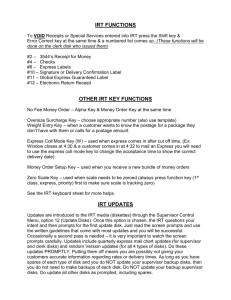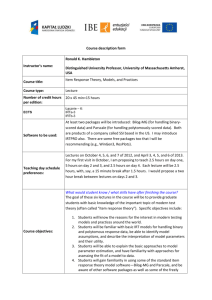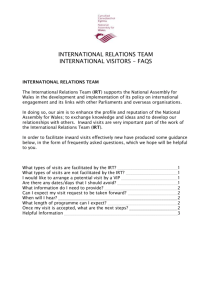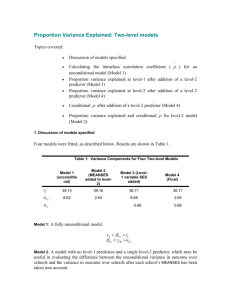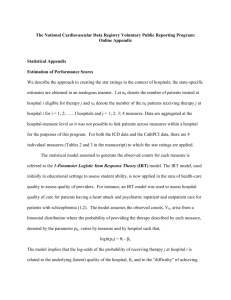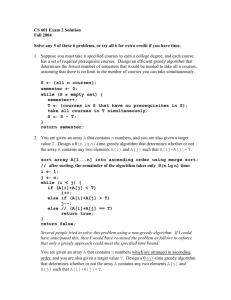12--14
advertisement
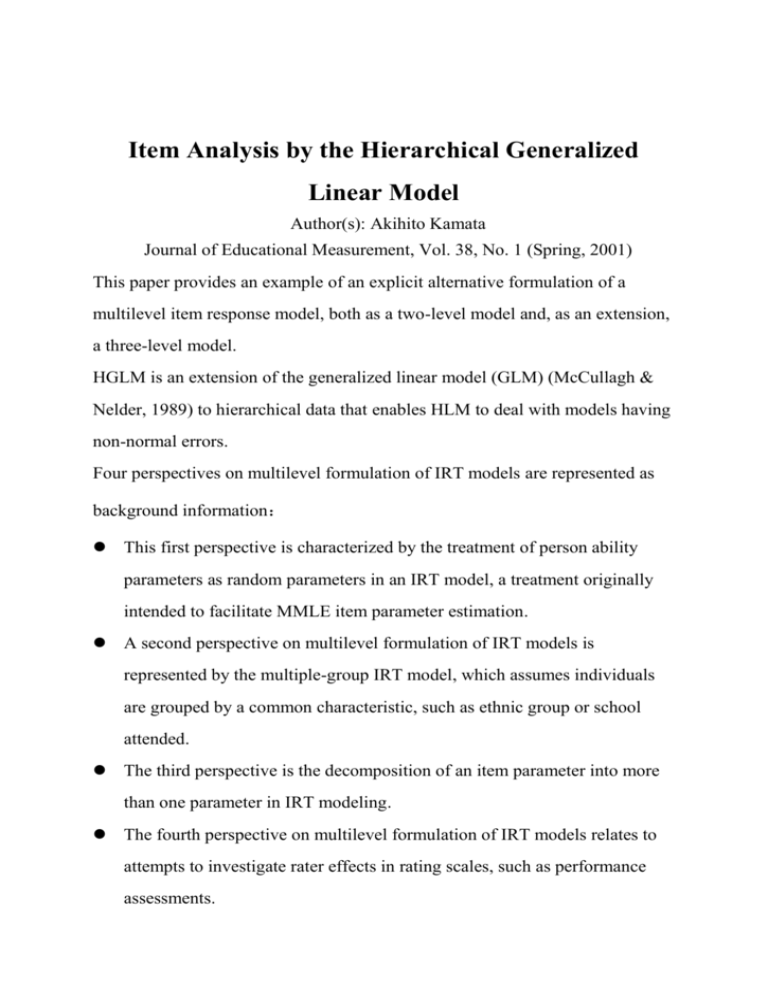
Item Analysis by the Hierarchical Generalized
Linear Model
Author(s): Akihito Kamata
Journal of Educational Measurement, Vol. 38, No. 1 (Spring, 2001)
This paper provides an example of an explicit alternative formulation of a
multilevel item response model, both as a two-level model and, as an extension,
a three-level model.
HGLM is an extension of the generalized linear model (GLM) (McCullagh &
Nelder, 1989) to hierarchical data that enables HLM to deal with models having
non-normal errors.
Four perspectives on multilevel formulation of IRT models are represented as
background information:
This first perspective is characterized by the treatment of person ability
parameters as random parameters in an IRT model, a treatment originally
intended to facilitate MMLE item parameter estimation.
A second perspective on multilevel formulation of IRT models is
represented by the multiple-group IRT model, which assumes individuals
are grouped by a common characteristic, such as ethnic group or school
attended.
The third perspective is the decomposition of an item parameter into more
than one parameter in IRT modeling.
The fourth perspective on multilevel formulation of IRT models relates to
attempts to investigate rater effects in rating scales, such as performance
assessments.
First, the two-level item analysis model is formulated and shown to be
algebraically equivalent to the Rasch model.
The two-level item analysis model is formulated following the GLM framework:
Level-1 is the item-model
The linear predictor model of a sampling distribution of item responses is
considered to be the level-1 model.
log(pij/(1- pij))= ij=0j+1j X1ij + 2j X2ij +…+kj Xkij
= 0j+∑𝑘𝑞=1 𝒒𝒋 𝑋𝒒𝒊𝒋
Pij: the probability that j gets item i correct
i: item (1,…, k )
j: person (1,…, n )
q: dummy variable q=1 when q=i or q=0
0j : intercept
qj: coefficient associated with Xqij
Level-2 is the person-model, in which 0j is assumed to be a random effect
across persons.
0j=00 +0j
1j=10
…
(k-1)j=(k-1)0
0j: random component of 0j
when level-l and level-2 models are combined, the linear predictor model is as
follows:
𝑝𝑖𝑗 =
1
1 + 𝑒𝑥𝑝{−[𝑢0𝑗 − (𝛾𝑞0 − 𝛾00 ]}
When i=q, the equation is algebraically equivalent to Rasch Model.
Next, a two-level item analysis model with person-characteristic variables
is presented, offering a means of analyzing the effects of the person
variables alone. Level-1 is the same, while a predictor variable is added in
level-2.
0j=00 +01W1j +…+ 0pWpj+ 0j*
1j=10
…
(k-1)j=(k-1)0
Wsj are person-level predictor measures for predictor s and person j.
Lastly, a three-level item analysis is presented that can provide estimates of
group-level abilities as well as person-level abilities, quantify the variation
of person-characteristic variable effects across groups, and reveal any
interaction effect between a group-characteristic variable and a
person-characteristic variable.
For example, a new level that represents school is added to the model.
Level-1——item-level model:
𝜂𝑖𝑗𝑚 = 𝛽0𝑗𝑚 + 𝛽1𝑗𝑚 𝑋1𝑖𝑗𝑚 + 𝛽2𝑗𝑚 𝑋2𝑖𝑗𝑚 + ⋯ + 𝛽(𝑘−1)𝑗𝑚 𝑋(𝑘−1)𝑖𝑗𝑚
i=1, .. , k-1
j=1, .. ,n
m=1, .. ,r
𝑋𝑞𝑖𝑗𝑚 : the qth dummy variable for the ith item for person j in school m
𝛽0𝑗𝑚 : the effect of the reference item
𝛽𝑞𝑗𝑚 : the effect of the qth item compared to the reference item
The level-2 models for the 𝛽𝑞𝑗𝑚 parameters assumed to be constant
across people are person-level models.
𝛽0𝑗𝑚 = 𝛾00𝑚 + 𝜇0𝑗𝑚
𝛽1𝑗𝑚 =𝛾10𝑚
𝛽2𝑗𝑚 =𝛾20𝑚
…
𝛽(𝑘−1)𝑗𝑚 =𝛾(𝑘−1)0𝑚
𝜇0𝑗𝑚 ~N(𝛾00𝑚 , τγ )
𝜇0𝑗𝑚 : how much personj in school m is deviated from the mean of
𝜇0𝑗𝑚 within school m
τγ : The variance of 𝜇0𝑗𝑚
τγ 𝛾𝑞0𝑚 :the effect of the ith item (for i = q) in school m, assuming the
effect of the kth item is zero.
level-3: school-level model could show that item effects are constant
across schools
For school m, we have
𝛾00𝑚 = 𝜋000 + 𝛾00𝑚
𝛾10𝑚 = 𝜋100
𝛾20𝑚 = 𝜋200
…
𝛾(𝑘−1)0𝑚 = 𝜋(𝑘−1)00
𝛾00𝑚 ~ 𝑁(0, 𝜏𝜋 )
𝜋000 is a fixed component of 𝛾00𝑚 , 𝛾00𝑚 is a random component, 𝜏𝜋 is
variance of the 𝛾00𝑚 .
The combined model is
𝑝𝑖𝑗 =
1
1 + 𝑒𝑥𝑝 {− [(𝛾00𝑚 + 𝜇0𝑗𝑚 ) − (−𝜋𝑞00 − 𝜋000 )]}
As an illustrative analysis, data from the Third International Mathematics
and Science Studies (TIMSS) are analyzed by the three-level model. 17
multiple-choice items done by 1,130 students from 68 schools are included in
the analysis.
This result presents evidence that the effect of studying science at home
on students' science literacy test scores depends on teachers' experience.
Comments:
The paper offers a full perspective for me to understand the HLM. The
principal and procedure from one step to another is very clear which is a good
material for new learners to know more about this kind of models. It also brings
me some ideas about my own research proposal.
At first, I have no idea why the Q dummy variable is needed in the model.
Though my thought may be wrong, I think it is for the item level analysis. With
this variable we can tell the difference among items or person, even school.
I think I need to do some real analysis to use the model instead of just
reading.
